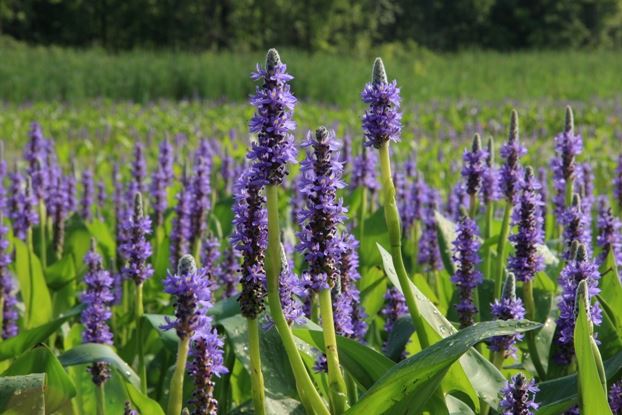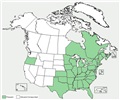Nature Nook
March, 2014
by John Rich
Pickerel Weed (Pontederia)
I'm going to try something different for this month's "Nature Nook" article. Instead of highlighting an exciting species of our furred, feathered or finned animal friends, I'm going to try to make a weed sound interesting. I know, that's going to be challenge, but stick with me and see if you like it. Plants can be exciting too, in their own unique way.
This month's feature is Pickerel Weed, scientific name Pontederia. I became interested in pickerel weed because I kept seeing it repeatedly along the banks of the waters in the cypress swamps of the Lake Charlotte area, east of Houston. And after seeing something numerous times, I have a curiousity to learn what it is. But instead of spending hours on the computer browsing the internet to figure it out, I just turned to good friend, fellow paddler and nature expert Natalie Wiest. "What are those pretty purple flowers?", I asked her. "That's pickerel weed", she instantly replied. There's no stumping Natalie. And now here I am to pass along that tidbit of nature knowledge to you.

Pickerel weed receives its name from the pickerel fish, also known as the northern pike, with which this plant is thought to coexist. Pickerel weed is an aquatic plant that grows in shallow freshwater, such as marshes, pond edges, lakes, and streamsides. It grows three to four feet tall, but you only see about the top half of it, because the rest is underwater. The leaves are large and heart-shaped, growing up to 10 inches long, at the end of a long stem. The stems under the water grow in the muddy bottom and spread with roots, to send up more stems to the surface. This plant is most often recognized by its beautiful flowers, with large spikes containing clusters of violet-blue flowers. Each individual flower is small, less than half an inch wide, and one of the petals will have two small yellow spots.
 |
|
 |
|
 |
|
 |
| Plant cluster |
|
Flower cluster |
|
Flower close-up |
|
Nuts |
Pickerelweed starts blooming in June and continues until November. Bees and other insects pollinate the flowers. After a flower has been pollinated, it dies and a fruit grows, consisting of a single small seed each. The seeds are good food for ducks and muskrats, and people sometimes eat the seeds too, which are a lot like nuts. This plant is perennial, which means that even though the leaves and stems die in the winter, the roots stay alive and start new growth each year. Pontederia is natural to the Americas, and is not an invasive species. It is distributed from Canada to Argentina, where it is found in shallow water or on mud. Pickerel weed is a popular plant in water gardens because of the beautiful flowers and leaves. They are also efficient biological filters of polluted wetland waters.
You've noticed that this plant has the word "weed" in its name. Weeds are generally defined as an undesirable plant, usually growing in profusion so as to crowd out more preferred species. However, in the case of pickerel weed in aquatic habitats, it is itself a desired crop and a native vegetation, that is essential for a healthy aquatic ecosystem. Therefore, pickerel weed is not really a weed.
 |
|
 |
| Range map, USA |
|
Range map, Texas |
Animals which use pickerel weed as a food source include muskrats, ducks, geese, deer, bees, snails, turtles and carp. Animals also use the plant for shelter, and this includes fish, snakes, crawfish, turtles, racoons, muskrats, beaver, snails, frogs and insects.
The plant was named by Swedish botanist Carl Linnaeus, in honor of the Italian botanist Giulio Pontedera. Linnaeus (1707 – 1778) was a botanist, physician, and zoologist who laid the foundations for the modern biological naming scheme of binomial nomenclature. He is known as the father of modern taxonomy, and is also considered one of the fathers of modern ecology. Giulio Pontedera (1688–1757), for whom Linnaeus named pickerel weed, was an Italian botanist, professor of botany, and director of a botanical garden.
 |
|
 |
|
 |
| Carl Linnaeus |
|
Giulio Pontedera |
|
Pontederia |
Now, for a story about a weed, that wasn't so boring, was it? You learned a few things, went back in time to the 1700's and around the world to Sweden and Italy to meet two interesting historical figures, and you'll probably never look at beautiful purple pickerel weed flowers quite the same again. You got all of that, out of a simple aquatic "weed".
 |
| The author, John Rich |